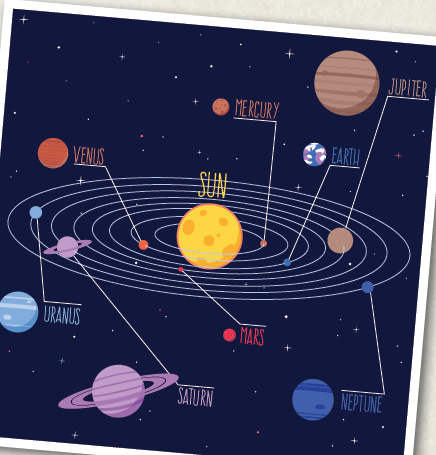ABOUT PLANETS
Earth is just one of the planets in our solar system. Planets are large bodies that rotate around the sun. They reflect its light and warmth. The planets that are located closest to the sun are made out of rocky material. They are relatively small and heavy. In contrast, the planets that are farther away from the sun are much larger. They are formed of light gases. All planets follow a certain path around the sun. They are held a specific distance from the sun by the sun’s strong gravitational force.
The inner planets, or those closest to the sun, are Mercury, Venus, Earth and Mars. Even though these planets are all small and rocky, they have more differences than they have things in common.
Because Mercury is the closest to the sun, the side that faces the sun gets as hot as 427° Celsius. At the same time, the side that faces away from the sun is a freezing -173° Celsius. Mercury also has a slower rate of rotation than Earth. Days and nights on Mercury are much longer than ours. The extreme temperatures alone make it a very unlikely place for life. With an atmosphere too thin for human breathing, it’s clear that people won’t be living on Mercury any time soon.
The next planet from the sun is Venus. Below clouds of sulfuric gas lies its 96% carbon dioxide atmosphere. That might be nice for a plant, since a plant “breathes” carbon dioxide, but not for a person. If you managed to survive the atmosphere, the surface of the planet is hot enough to melt solid metal. In addition, the pressure of the air would be strong enough to crush you.
You are probably most familiar with Earth because we are its inhabitants. It has the perfect conditions for life. Earth’s atmosphere and oceans help control the trickiest part of making a planet life-friendly: temperature.
Earth is the only planet known to have liquid water. Mars is the fourth farthest from the sun. Mars has been studied and photographed more than any other planet besides Earth. Some people think it may be possible for life to exist there. Although scientists have not been able to find actual water on Mars, there seems to be evidence of water erosion on its surface. Its canyons and mountains tend to be very similar to those found on Earth. The main difference is that there is no plant life. Some scientists believe that Mars may have been very much like Earth until something happened that made the water supply evaporate.

